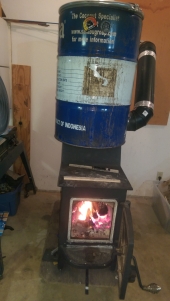I'm finalising the design for my 5" sidewinder batch box rocket stove.
I've a length of 5" diameter stove pipe in the workshop and was going to use it as a sacrificial form for the heat riser My plan is to surround the pipe with a vermiculite/high alumina cement mix. I'm sure the pipe will badly corrode in the riser (I know, metal is doomed...

) but I'm hoping the cast vermiculite/alumina cement will hold its shape and be able to cope with the riser temperatures once the enamelled pipe has failed. What do you think? One of my concerns is that sections of the corroded pipe may fall to the base of the riser and block the port entry from the firebox.
I like the idea of casting the insulated riser around a form. I've had great success using a 6" stove pipe surrounded by a vermiculite/alumina cement mix in my workshop rocket stove. I investigated the condition of the steel pipe in that heater today and noticed only minor corrosion near the base of the riser - mind you, this is in a 'J' tube set-up and it appears that higher temps can be achieved using a batch box.
Another alternative perhaps would be to make a 5" cardboard laminated 'tube' from several layers of corrugated packing card, use this as the form and then burn it out on first fire-up.
Thanks as always for any help or advice.










